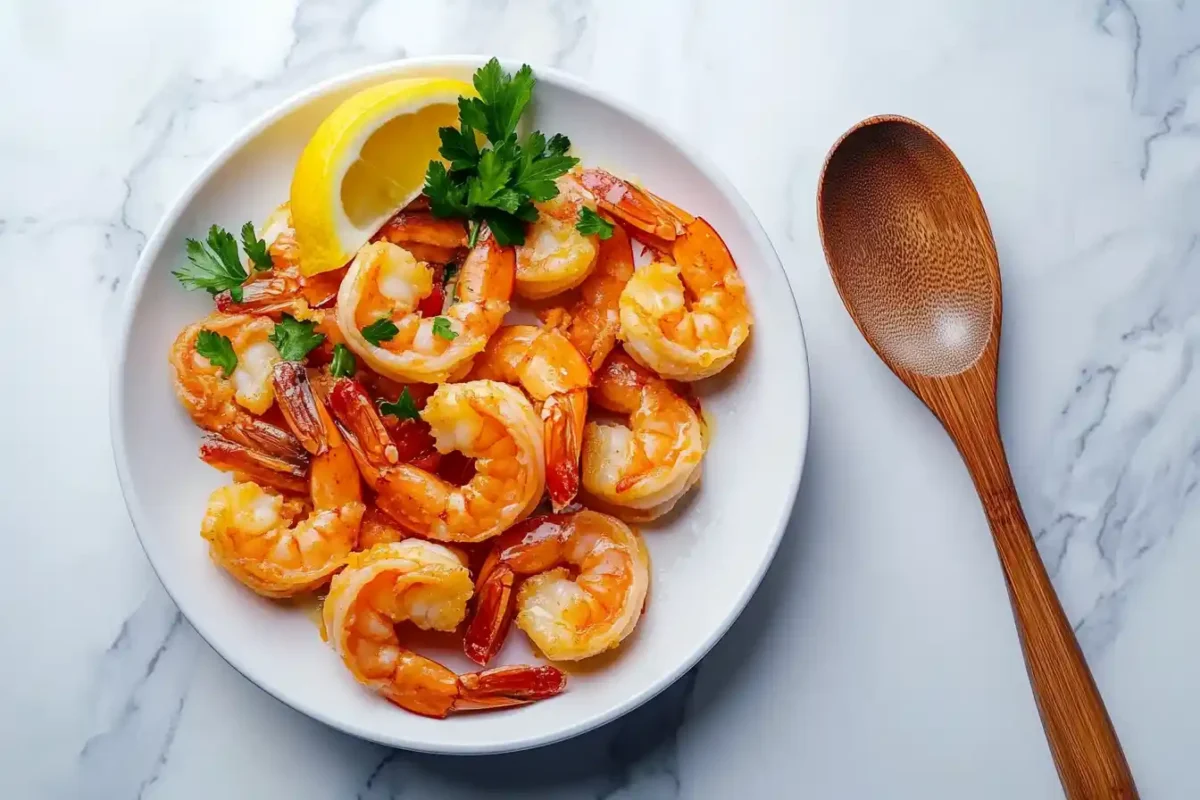Introduction and Nutritional Differences
Is it Best to Cook Shrimp in Butter or Oil?
Shrimp is a versatile protein beloved for its delicate taste and quick cooking time. When deciding whether to Cook shrimp butter or oil, understanding what each medium brings to the table is essential. Some prefer the richness of butter, while others opt for the healthier, neutral profile of oil.
The secret to perfectly cooked shrimp? The right fat, the right heat, and just the right seasoning. Let’s break it down and see which option might be better for your health, your tastebuds, and your dish!
Overview of Shrimp Cooking Methods
Cooking shrimp isn’t a one-size-fits-all method. Some methods require slow sautéing with delicate fats, while others need the high heat tolerance that certain oils offer.
- Sautéing Shrimp: Often done with either butter or olive oil for added flavor.
- Pan-searing Shrimp: Needs oil with a higher smoke point to prevent burning.
- Grilling Shrimp: Requires oils that can handle extreme temperatures like avocado oil, as highlighted in the best way to barbecue shrimp.
By choosing wisely between butter and oil, you can customize the cooking process to suit your needs.
Nutritional Differences Between Butter and Oil
Nutritional Comparison of Butter vs. Oil for Cooking Shrimp (Per 100g)
| Nutrient | Butter (Unsalted) | Olive Oil | Avocado Oil |
|---|---|---|---|
| Calories | 717 kcal | 884 kcal | 884 kcal |
| Total Fat | 81g (mostly saturated) | 100g (mostly monounsaturated) | 100g (mostly monounsaturated) |
| Saturated Fat | 51g | 14g | 12g |
| Monounsaturated Fat | 21g | 73g | 70g |
| Polyunsaturated Fat | 3g | 8g | 13g |
| Cholesterol | 215mg | 0mg | 0mg |
| Sodium | 11mg | 0mg | 0mg |
| Vitamin A | 684mcg (76% DV) | 0mcg | 0mcg |
Butter’s Nutritional Profile:
Butter is rich in saturated fats, giving it that creamy taste. However, its fat content isn’t all bad—it contains healthy fat-soluble vitamins like A, D, and K.
- Calories: About 100 calories per tablespoon
- Fat Content: 11 grams of fat (mostly saturated)
- Best for: Quick, flavorful sautés at low-to-medium heat
Oil’s Nutritional Profile:
Oils such as olive, avocado, and grapeseed oil have gained popularity for their heart-healthy fats. Unlike butter, they offer monounsaturated fats, which help balance cholesterol levels.
- Calories: About 120 calories per tablespoon (varies slightly depending on the type of oil)
- Fat Content: 14 grams of fat (mostly unsaturated)
- Best for: High-heat cooking, stir-frying, or pan-searing
Some oils, such as olive oil, also contain antioxidants that enhance your dish and your health.
By considering the nutritional profiles of both butter and oil, you’ll get an idea of what suits your diet and cooking style best.
Cooking Shrimp in Butter – Pros and Cons
Why Cook Shrimp in Butter?
Butter has long been a go-to fat for cooking shrimp, and for good reason—it adds a luxurious richness that few other fats can match. Whether you’re whipping up a quick weeknight meal or preparing an impressive dinner, butter can turn a simple shrimp dish into something unforgettable. But, as with all cooking choices, it’s important to weigh the pros and cons.
Flavor Profile of Butter-Cooked Shrimp
When shrimp meets sizzling butter, magic happens!
- Rich, Creamy Taste: Butter adds a smooth, velvety richness that amplifies the shrimp’s natural sweetness. It creates a decadent mouthfeel, making each bite irresistibly tender.
- Maillard Reaction: As butter heats up, it undergoes the Maillard reaction—a chemical process that browns the shrimp’s surface, enhancing caramelization and delivering a subtle nuttiness. The result? Golden-brown, crispy edges that taste heavenly.
- Perfect Pairing with Garlic, Lemon, and Herbs: Butter’s mild, creamy profile complements bold ingredients like garlic, lemon juice, and fresh parsley, elevating simple recipes like garlic butter shrimp to a new level.
This flavor combination is particularly popular in Mediterranean and seafood dishes where shrimp’s delicate taste shines through buttery goodness.
Advantages of Using Butter
Despite butter’s humble reputation, it brings several practical advantages to cooking shrimp:
- Quick and Even Browning: Butter’s fat content allows it to distribute heat evenly, ensuring that each shrimp cooks consistently. You’ll get beautifully seared shrimp without dry or overcooked spots.
- Creates a Sauce Base:Butter doesn’t just cook your shrimp—it creates an instant, flavorful sauce, perfect for creamy, buttery seafood dishes, like those found in this crab brulee recipe. Toss in some garlic, lemon zest, and chili flakes, and voilà: you’ve got a buttery sauce ready to coat every shrimp in savory bliss.
- Enhances Flavor with Minimal Seasoning: Butter has a way of infusing shrimp with deep flavor, even without adding extra seasoning. A sprinkle of salt and a squeeze of lemon can be all you need.
Not only is it convenient, but it also reduces the need for multiple ingredients while maintaining complexity in taste.
Downsides of Using Butter
Of course, nothing’s perfect—butter has a few notable drawbacks when it comes to cooking shrimp:
- Low Smoke Point: Butter’s low smoke point (around 350°F or 175°C) means it can burn quickly if the heat is too high. Burnt butter can develop a bitter, unpleasant taste and can make shrimp overcook rapidly.
- Prone to Overcooking Shrimp: Since shrimp cook fast (typically 2–3 minutes per side), butter’s sensitivity to heat can increase the risk of overcooking. This leaves little room for error if you’re not watching the pan closely.
- Higher Saturated Fat Content: Compared to heart-healthy oils like olive or avocado oil, butter contains more saturated fats. For those watching their cholesterol or following a low-fat diet, this could be a downside.
That said, occasional indulgence in a delicious, butter-cooked shrimp dish can still fit into a balanced lifestyle, especially when combined with fresh veggies or whole grains.
Best Types of Butter for Cooking Shrimp
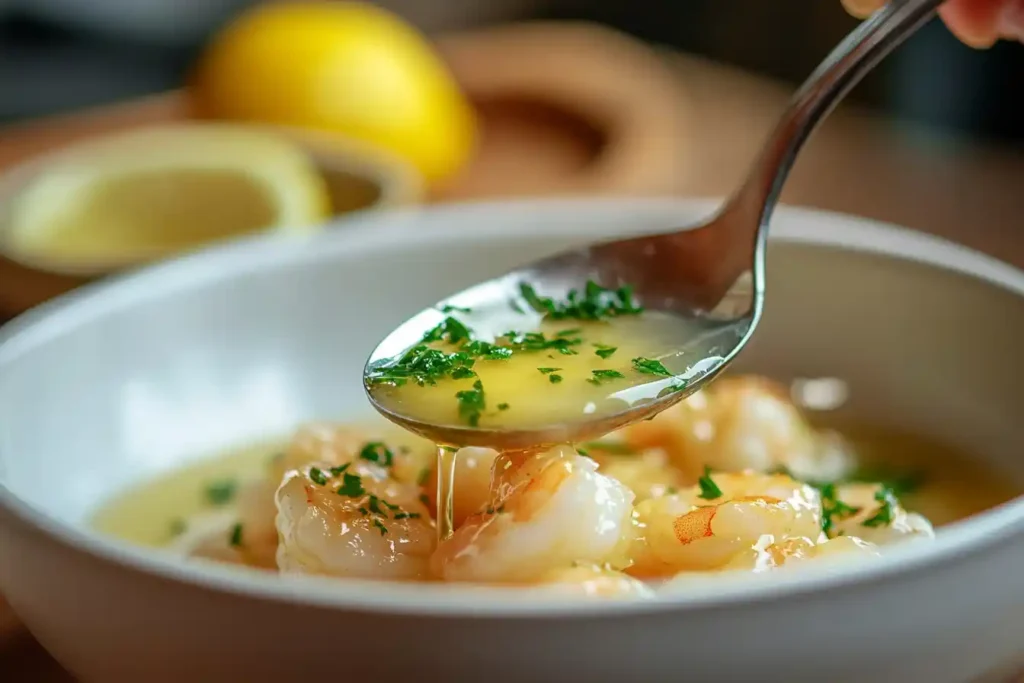
Not all butter is created equal! Choosing the right type of butter can significantly improve your shrimp’s texture and taste.
- Clarified Butter (Ghee): Clarified butter is regular butter that has had its milk solids and water removed, leaving behind pure butterfat. This process raises the smoke point, making it more suitable for high-heat cooking. Shrimp cooked in clarified butter develops a golden, crispy exterior without the risk of burning.
- Grass-Fed Butter: Grass-fed butter has a richer flavor and a creamier consistency due to the cows’ grass-based diet. It often contains higher levels of omega-3 fatty acids and vitamins, making it a more flavorful and nutrient-rich option.
Clarified butter is your best bet if you love high-heat cooking methods, while grass-fed butter is ideal for low-to-medium heat sautés where you want the full richness of regular butter.
Cooking Shrimp in Oil – Pros and Cons
Why Cook Shrimp in Oil?
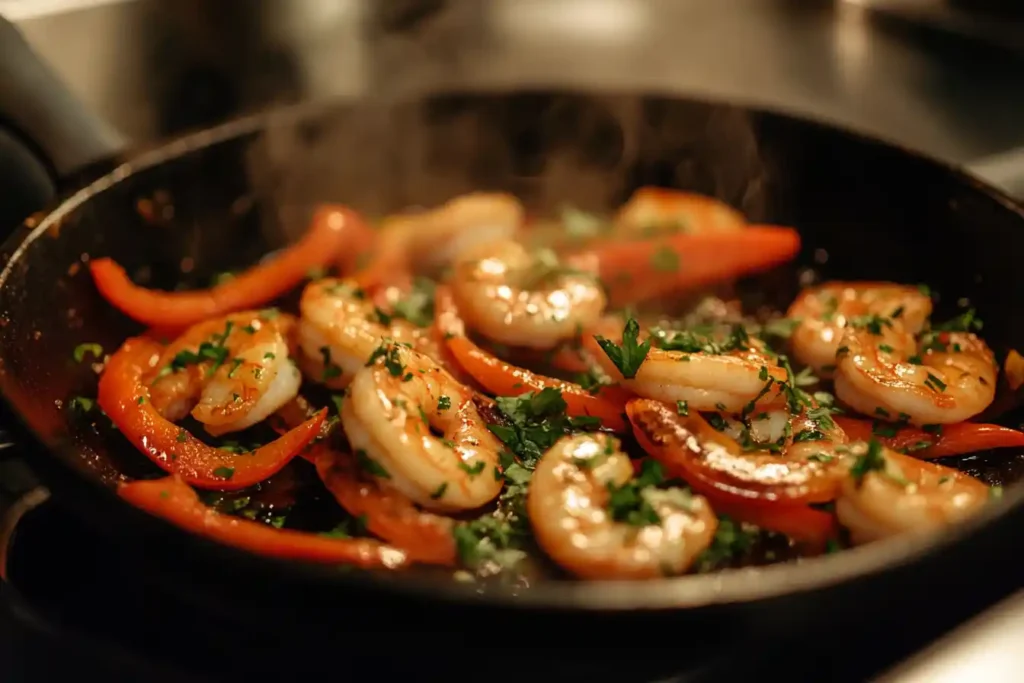
Cooking shrimp in oil offers a world of possibilities, especially when you want a dish that’s light, crisp, and healthy. Unlike butter, which adds richness, oils provide a more neutral or complementary base that allows the shrimp’s natural sweetness to shine. Whether you’re stir-frying, pan-searing, or grilling, oil is a versatile option that holds up to high temperatures without losing its structure—or burning!
Flavor Profile of Oil-Cooked Shrimp
Different oils lend unique flavors to shrimp dishes. The type of oil you choose can transform a meal from simple to sensational.
- Neutral Oils (Canola, Vegetable): These oils have little to no flavor, making them great for recipes where you want the shrimp’s natural taste to take center stage. They’re perfect for Asian-inspired stir-fries or crispy shrimp tacos.
- Olive Oil: This versatile oil imparts a light, fruity taste, especially when you use extra-virgin olive oil. Mediterranean shrimp recipes, like shrimp with tomatoes and feta, benefit from this subtle yet distinct flavor.
By choosing the right oil, you can enhance or preserve the shrimp’s delicate profile depending on the type of dish you’re preparing.
Advantages of Using Oil
Cooking shrimp in oil has several benefits, especially for those looking to make heart-healthy, quick meals:
- Higher Smoke Point: Oils like avocado, grapeseed, and canola oil have higher smoke points than butter, which means they can handle high-heat cooking methods like searing and stir-frying without breaking down or burning. This results in beautifully crispy, golden shrimp.
- Healthier Fats: Oils such as olive oil and avocado oil contain monounsaturated fats, which are known for their heart-healthy benefits. These oils can help lower bad cholesterol while adding flavor to your meals.
- Great for Pan-Frying and Stir-Frying: When you need shrimp to cook fast without sticking to the pan, oils provide a slick, even surface that prevents overcooking and ensures consistent browning.
Shrimp cooked in oil also tends to have a firmer texture with a lightly crispy exterior, making it ideal for recipes where you want a slight crunch.
Downsides of Using Oil
Despite its versatility, cooking shrimp in oil isn’t always a perfect option. Here are a few potential drawbacks to keep in mind:
- Less Rich Flavor Compared to Butter: While oils can enhance certain flavors, they don’t provide the creamy, indulgent taste that butter offers. Some dishes, like garlic butter shrimp, just don’t hit the same when cooked in oil.
- Strong Oils Can Overpower the Dish: Some oils, such as extra-virgin olive oil or unrefined coconut oil, have bold flavors that can dominate the delicate taste of shrimp, as noted in several chicken and shrimp recipes.If you’re not careful, the shrimp may end up tasting more like the oil than the main ingredient.
- Requires Additional Seasoning: Since oil lacks the built-in richness of butter, you may need to add more spices, citrus, or herbs to build layers of flavor. Without proper seasoning, oil-cooked shrimp can taste a bit bland.
It’s worth experimenting with different types of oil to find the balance that works best for your taste preferences and cooking style.
Best Types of Oil for Cooking Shrimp
When it comes to cooking shrimp, not all oils are created equal. Some shine in stir-fries, while others are better suited for gentle sautéing.
- Avocado Oil: Known for its incredibly high smoke point (around 520°F), avocado oil is perfect for high-heat cooking methods like searing or grilling shrimp. It has a mild, buttery flavor that won’t overpower the shrimp.
- Olive Oil (Extra Light): If you want the health benefits of olive oil without the strong flavor, opt for extra light olive oil. This type of olive oil is refined for sautéing and frying, offering a neutral profile with a moderate smoke point (around 465°F).
- Coconut Oil: With its tropical, slightly sweet aroma, coconut oil works well for shrimp dishes that feature bold spices, like curry or Caribbean-inspired meals. However, be mindful that unrefined coconut oil’s strong scent may not suit all recipes.
By using the right type of oil, you can bring out the shrimp’s best qualities—whether you’re aiming for a light, crispy texture or a flavorful, aromatic profile.
Part 4: Comparison – When to Use Butter or Oil
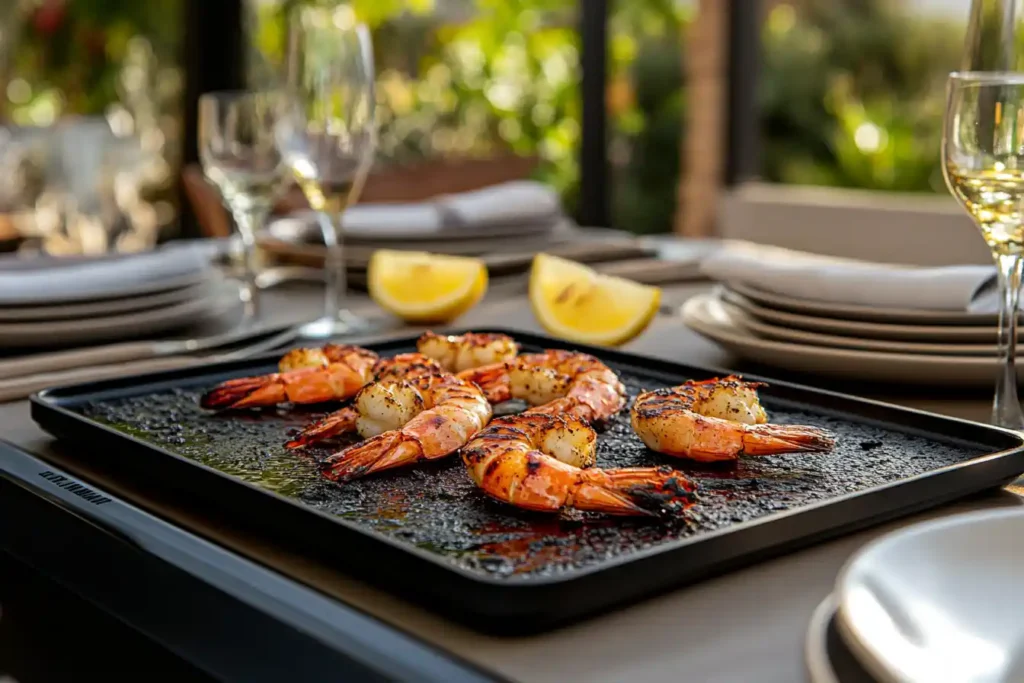
When it comes to cooking shrimp, the choice between butter and oil often boils down to your priorities: flavor, health, or cooking method. Both fats bring something special to the table, but they shine in different ways depending on the dish you’re preparing. Let’s break it down and help you decide when to reach for butter and when oil is your best bet.
Flavor vs Health: Choosing the Right Medium
If your goal is to make a dish rich and decadent, butter is the clear winner.
- Butter: Perfect for indulgent meals, like garlic butter shrimp, where the creamy, savory flavor is key to the dish. The way butter caramelizes adds an irresistible golden-brown crust.
- Oil: Opt for oil if you’re aiming for a lighter, healthier meal. Olive oil, in particular, offers heart-healthy fats that can enhance shrimp dishes without weighing them down.
In short, butter is your go-to for special occasions, while oil can be your everyday hero for balanced meals.
Cooking Methods and Preferences
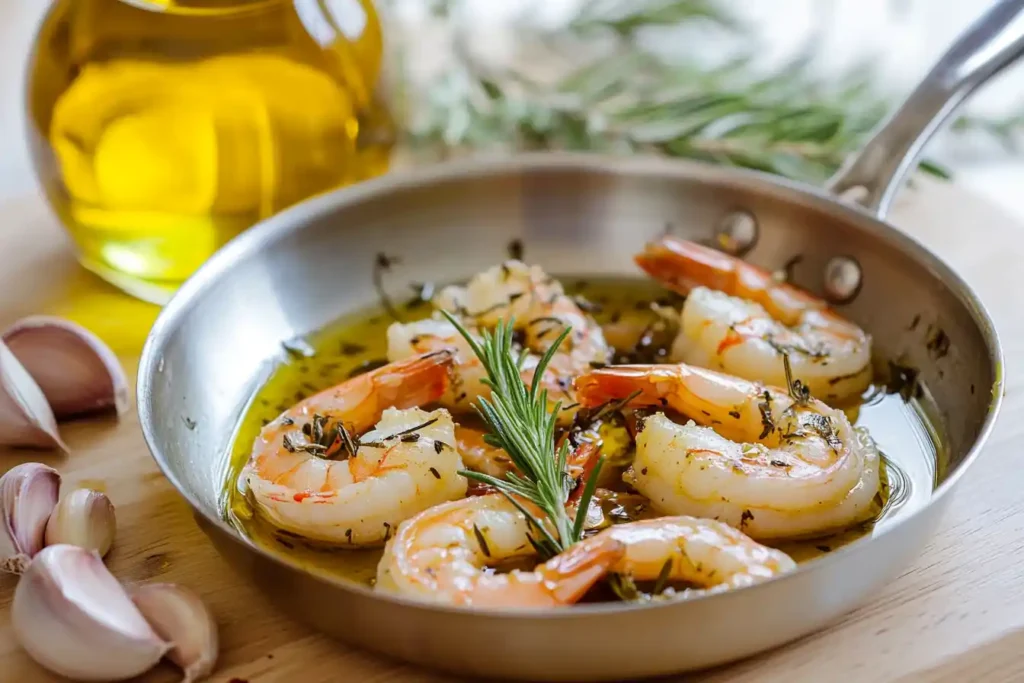
Different cooking methods require different fats, and choosing wisely can prevent burnt butter or soggy shrimp.
- Butter for Low-to-Medium Heat Dishes: Dishes like shrimp scampi or creamy pastas benefit from butter’s low smoke point. It’s ideal for sautéing over gentle heat to prevent burning.
- Oil for High-Heat Cooking: If you’re stir-frying or grilling shrimp, oils with higher smoke points (like avocado or canola oil) are better suited, especially when considering whether to cook shrimp with the shell on or off, as discussed in this barbecuing shrimp guide. They can withstand higher temperatures, resulting in crispy, flavorful shrimp.
Matching the cooking medium to the heat level is key to avoiding bitter or burnt flavors.
Dietary Preferences and Restrictions
Your dietary goals can also influence whether you should use butter or oil.
- Keto-Friendly Considerations: Butter is often favored for keto-friendly dishes because of its high fat content and low carbohydrates.
- Mediterranean Diet Preference: Olive oil takes center stage in the Mediterranean diet, thanks to its unsaturated fats and anti-inflammatory properties.
Ultimately, both butter and oil can fit into most diets—it’s all about portion control and balancing flavors.
Situational Use Cases for Butter vs Oil
- Sautéing: Butter provides a rich base for shrimp sautés, especially when paired with garlic and herbs.
- Baking: A mix of butter and oil can keep shrimp moist without overpowering the dish.
- Grilling and Stir-Frying: Oil—particularly avocado or grapeseed—is essential for maintaining moisture without sticking to the grill or pan.
Interestingly, combining butter and oil can give you the best of both worlds. The oil raises the smoke point, while the butter adds depth of flavor. For instance, you can sear shrimp in a mix of olive oil and butter to get golden-brown edges without burning the fats.
Frequently Asked Questions About Cook shrimp butter or oil
Can I Use Both Butter and Oil to Cook Shrimp?
Absolutely! Combining butter and oil is a great way to get the best of both worlds. The oil raises the smoke point, making it suitable for higher heat, while the butter adds a rich, creamy flavor. This prevents the butter from burning too quickly while still delivering that golden-brown, caramelized finish. For example, a mix of olive oil and butter is perfect for sautéing shrimp with garlic and herbs.
What Type of Oil Is Best for Cooking Shrimp?
The best oil for shrimp depends on your cooking method:
Sautéing: Extra-light olive oil or grapeseed oil provides a neutral, clean taste.
Stir-Frying: Avocado oil has a high smoke point and mild flavor, making it perfect for high-heat stir-frying.
Baking: A drizzle of olive oil keeps shrimp moist without overpowering the flavors.
Each oil has its unique qualities, but those with high smoke points help prevent burnt shrimp when cooking at high temperatures.
Is Clarified Butter Better Than Regular Butter for Shrimp?
Yes! Clarified butter, also known as ghee, has had its water and milk solids removed, resulting in pure butterfat. This process raises the smoke point significantly, making clarified butter less likely to burn. It’s an excellent choice for searing shrimp at medium-high heat while still retaining that signature buttery richness.
Is Olive Oil or Butter Healthier for Shrimp?
Olive oil tends to be the healthier choice due to its monounsaturated fats and antioxidants. It can help lower cholesterol and support heart health. Butter, while rich in flavor, contains higher levels of saturated fats, which should be enjoyed in moderation. However, grass-fed butter has some added benefits, like higher omega-3 content.
Final Thoughts on the Best Cooking Medium for Shrimp
Choosing between butter and oil when cooking shrimp ultimately depends on your preferences and the type of dish you’re preparing.
If you’re craving rich, indulgent shrimp dishes like garlic butter shrimp, butter is your best friend. On the other hand, for lighter, healthier meals or high-heat cooking methods, oil—especially olive or avocado oil—delivers both flavor and crispness.
The key is experimenting to find the right balance. Try combining both butter and oil for the best of both worlds—enhanced flavor with less risk of burning. Whether you’re making stir-fry, scampi, or baked shrimp, knowing when to use butter or oil helps you create dishes that wow every time. Happy cooking!
Would you like suggestions for inbound and outbound links?

